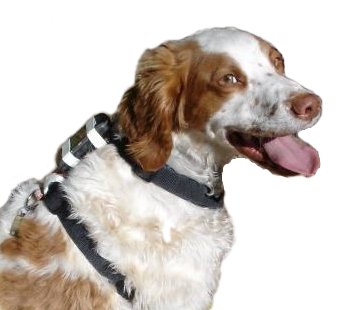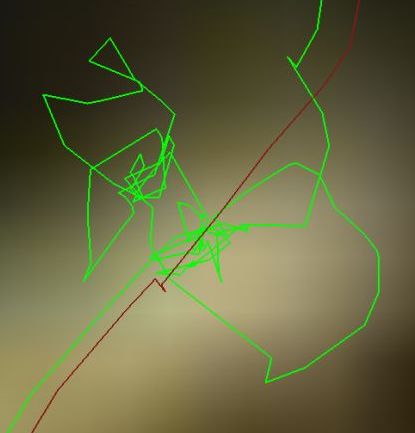[NOTE: This is the third installment in the "Run, Duke, Run!" series. If you have not read chapter 1 and chapter 2, you might want to do that now.]

Curious minds want to know just how much farther a dog travels. And this is exactly the kind of research at which flyingcracker.com excels. In this,our third, episode we have new and improved results of the canine v. human distance calculation. But first, a short recap...
At left is our hero, Duke, patiently waiting the GO signal during the latest experiment, a re-enactment of the Reno-Flag-Bear-Deadman bike ride undertaken a few months ago. As you certainly remember from episode one, Duke was outfitted with a Garmin Forerunner 301 GPS. We traveled the Reno--Deadman trails twice and compared Duke's GPS track with the bicycle GPS track. Duke ran approximately 18.5% more than the bike rider. However further analysis found that the 301 GPS had trouble acquiring GPS satellite signal in some situations.
In episode two we ran Duke on a short hike with the new improved Garmin Edge 305 GPS. We noticed several big changes. This GPS had no apparent loss of GPS signal and Duke's travelling distance increased significantly in comparison with the hiker. But we realized that a short hike cannot easily be compared with a long faster bike ride. Obviously more research was needed.
On September 11th we set about re-riding Reno-Flag-Bear-Deadman, a nineteen mile expert-level mountain bike ride. The ride starts at the Deadman Trailhead on Cement Creek Road and two miles later climbs four miles up Italian Mountain road to Reno Divide. From there you swoop down Flag Creek, climb up Trail 426, rip down Bear Creek, climb up Deadman Gulch, and finally navigate the tricky Deadman switchbacks back to the trailhead.
We mounted the Edge 305 on our bicycle and rode the trail at a normal pace. We stopped at the normal lunch spots and took the standard rest breaks. According to our SportTracks GPS software, we rode 19.17 miles in 2:58:16 for an average of 6.45 mph. We stopped a total of 52 minutes 18 seconds. Please, no comments about our leisurely pace, sometimes you just have to lie back and watch the clouds roll by and remember what once was.
On September 29th we rode forth again. This time Duke was especially excited because we brought along John and Robin Norton's dog Page. Page is a Dalmation mix rescue dog who John assured me would run and run. Unfortunately Page didn't seem to want to go on a bike ride and instead turned south not long after we began and headed back to the tepee, so to speak. Within an hour she had run seven miles down the road to her home. So we guess John was right, Page can run and run, just not in the desired direction. We re-grouped at the trailhead an hour later and began again.

Snow had fallen in the intervening weeks and quite a bit of Italian Mountain road was snow-covered. Our riding buddies Jimmy and Jack had forged ahead and, upon not seeing them again we figured the trail was rideable. Later we estimated 20% of the ride was over packed snow.

The top of Reno Divide was dry so we stopped for pics. Note the ingenious placement of flyingcracker.com stickers on our Fox RLT fork. [ Note: We just received a new shipment of stickers, read here for details about how you can obtain a few for yourself.]
 During lunch above the Bear Creek downhill Duke spent most of his time exploring the countryside. The bicycle track is in dark red and Duke's track is green. Our lunch spot is where the red track has a slight hitch.
During lunch above the Bear Creek downhill Duke spent most of his time exploring the countryside. The bicycle track is in dark red and Duke's track is green. Our lunch spot is where the red track has a slight hitch.
As you can see, Duke covered quite a lot of ground while we were stopped. However, while we were moving, especially downhill, Duke remained near the path, often in the brush to one side or another. We think this behaviour was caused by two factors.
One, Duke didn't have a canine running partner. During our first experiment Duke ran with Margo, another fit Brittany. With the defection of Page on this run Duke didn't have another dog to goad him on. Just as one child might be fairly quiet when alone but a holy terror when joined by one or two buddies, Duke by himself wisely kept (mostly) to the straight and narrow.
Secondly, Duke put in several miles during our first (aborted) start and recovery of Page. Further, the evening prior to this experiment Duke ran a top-speed version of the four mile Strand Bonus trail. So we're guessing he was a bit tired and sore.
We believe these factors added up to keep Duke closer to the trail than normal. We will examine these and other issues in episode four.
The remainder of the ride was generally uneventful - Duke often rolled in the snow fields when we stopped. Luckily the Edge 305 is waterproof! Duke explored the Deadman Gulch beaver ponds. On the Deadman switchback downhill we saw an unusual sight - aspen leaves covering snow. Duke helpfully posed for us here . His beefy chest makes him look quite strong. We promise he takes no steroids (as far as we know).

Our final image shows Duke's track (green) down the Deadman switchbacks superimposed with the bicycle track (in red). Note you can count every one of the thirty-one switchbacks courtesy of the much-improved Edge 305 GPS. We have numbered a few of the right-turn switchbacks to make your counting easier. On this downhill Duke followed the bicycle quite closely.

The final tally shows Duke ran 22.98 miles on this excursion. This does not include the extra mileage at the false start of our trip. His total time is unknown because of our starting problems but doesn't matter anyway - we are only concerned with distance. So in our second Reno experiment Duke ran 20% more than the bicycle rider. Again this is less than we expected but his result points out a number of interesting factors. One, observation shows that Duke runs farther with one or two additional dogs along. Two, recent significant physical activity may reduce the distance a dog travels. Three, the human's speed has a huge impact on the additional distance covered by the dog. Four, ... Hey, wait a minute. We have to save something for our next episode!
Needless to say we have learned more than we expected at the start of this journey. Episode four will conclude the Run, Duke, Run! series with a detailed analysis of the various physical and environmental factors that affect how much farther a dog runs.And best of all, we will provide a special web page where you can determine how much farther your dog travelled on your own journey. Stay tuned!